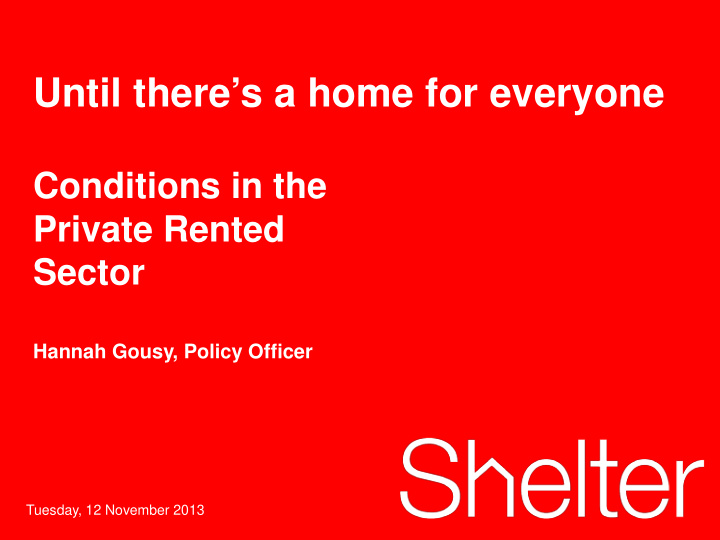



Until there’s a home for everyone Conditions in the Private Rented Sector Hannah Gousy, Policy Officer Tuesday, 12 November 2013 1
Outline 1.Conditions in the private rented sector 2.Shelter’s work to improve private renting 3.Selective licensing 2
What do Shelter do? Shelter is committed to improving the security and conditions for the increasing number of families living in the PRS. Our aim is to support responsible landlords , educate tenants and expose the small but dangerous minority of rogue landlords who take advantage of their tenants. We provide online advice pages for tenants. 2.8 million people visited the advice pages last year. We run a helpline and face to face services . Last year they provided support to more than 100,000 people Enquiries about private renting make up more than 40% of our advice work- the most common problems are disputes with landlords and problems with poor conditions and disrepair . We also campaign for wider change to housing policy 3
Why is Shelter concerned? 1 in 5 families now rent— this proportion has doubled in 6 years (1 in 10 rented 6 years ago). Fewer than 1 in 10 families are renting because they like the freedom and flexibility it gives them In the last year 28% of families have not had repairs carried out or poor conditions dealt with by their landlord or letting agent. One million renters say their health has been affected by their landlord failing to make repairs or dealing with poor conditions. 4
Poor conditions in the private rented sector 35% of private rented homes are classified as ‘non-decent’ compared to 22% of owner occupied and 17% of social rented homes. The causes? • Amateur Landlords - The sector is dominated by individual landlords owning one or two properties, who lack awareness of their rights and responsibilities. • High demand markets- few incentives to improve the condition of their stock. 80% of landlords expected to re let their properties if they became vacant tomorrow. Almost 60% of these landlords would expect to re-let at a higher rent and only 1% at a lower rent. • A lack of tenant bargaining power- Tenants often do not report poor conditions for fear of retaliatory eviction or non- renewal of a tenancy. 5
Evict Rogue Landlords Over a third of local authorities are Tough enforcement action against rogue signed up to landlords, and publicise prosecutions. the campaign Proactively manage and inspect properties Adequately resource and support their local enforcement teams. Educate tenants and landlords of their rights and responsibilities. Accreditation and licensing schemes. 6
Longer tenancies 2/3 of renters would like to have the option of staying in their tenancy for longer . 4/5 of renters would like to know their rent cannot be increased above a certain level 1 in 10 renting families have had to change their children’s school due to moving . 34% of families who have moved in the past five years said the move strained their finances. 7
Longer tenancies Longer, more secure tenancies can help provide tenants with greater consumer bargaining power to demand better conditions. 8
Is licensing the way forward? Selective licensing is now being used by many local authorities to address problems in the private rented sector. Helps local authority enforcement officers to identify privately rented properties in their area. Provides an opportunity for decent landlords to identify themselves, making it easier for local enforcement officers to prioritise identifying and inspecting unlicensed properties. Allows you to better target services to landlords to improve their practice. 9
Recommend
More recommend